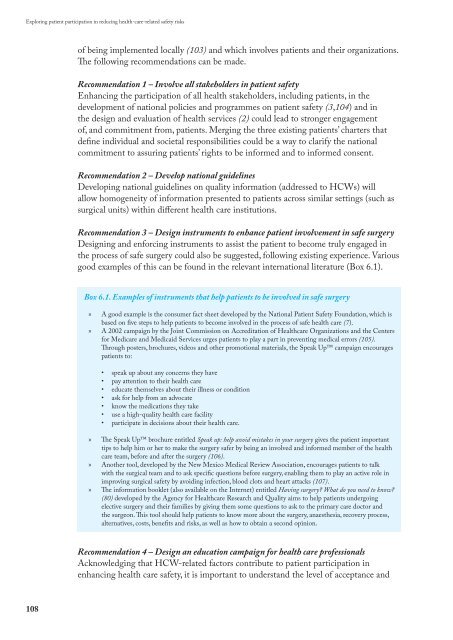Exploring patient participation in reducing health-care-related safety risks
Exploring patient participation in reducing health-care-related safety risks
Exploring patient participation in reducing health-care-related safety risks
Create successful ePaper yourself
Turn your PDF publications into a flip-book with our unique Google optimized e-Paper software.
<strong>Explor<strong>in</strong>g</strong> <strong>patient</strong> <strong>participation</strong> <strong>in</strong> reduc<strong>in</strong>g <strong>health</strong>-<strong>care</strong>-<strong>related</strong> <strong>safety</strong> <strong>risks</strong><br />
108<br />
of be<strong>in</strong>g implemented locally (103) and which <strong>in</strong>volves <strong>patient</strong>s and their organizations.<br />
The follow<strong>in</strong>g recommendations can be made.<br />
Recommendation 1 – Involve all stakeholders <strong>in</strong> <strong>patient</strong> <strong>safety</strong><br />
Enhanc<strong>in</strong>g the <strong>participation</strong> of all <strong>health</strong> stakeholders, <strong>in</strong>clud<strong>in</strong>g <strong>patient</strong>s, <strong>in</strong> the<br />
development of national policies and programmes on <strong>patient</strong> <strong>safety</strong> (3,104) and <strong>in</strong><br />
the design and evaluation of <strong>health</strong> services (2) could lead to stronger engagement<br />
of, and commitment from, <strong>patient</strong>s. Merg<strong>in</strong>g the three exist<strong>in</strong>g <strong>patient</strong>s’ charters that<br />
def<strong>in</strong>e <strong>in</strong>dividual and societal responsibilities could be a way to clarify the national<br />
commitment to assur<strong>in</strong>g <strong>patient</strong>s’ rights to be <strong>in</strong>formed and to <strong>in</strong>formed consent.<br />
Recommendation 2 – Develop national guidel<strong>in</strong>es<br />
Develop<strong>in</strong>g national guidel<strong>in</strong>es on quality <strong>in</strong>formation (addressed to HCWs) will<br />
allow homogeneity of <strong>in</strong>formation presented to <strong>patient</strong>s across similar sett<strong>in</strong>gs (such as<br />
surgical units) with<strong>in</strong> different <strong>health</strong> <strong>care</strong> <strong>in</strong>stitutions.<br />
Recommendation 3 – Design <strong>in</strong>struments to enhance <strong>patient</strong> <strong>in</strong>volvement <strong>in</strong> safe surgery<br />
Design<strong>in</strong>g and enforc<strong>in</strong>g <strong>in</strong>struments to assist the <strong>patient</strong> to become truly engaged <strong>in</strong><br />
the process of safe surgery could also be suggested, follow<strong>in</strong>g exist<strong>in</strong>g experience. Various<br />
good examples of this can be found <strong>in</strong> the relevant <strong>in</strong>ternational literature (Box 6.1).<br />
Box 6 .1 . Examples of <strong>in</strong>struments that help <strong>patient</strong>s to be <strong>in</strong>volved <strong>in</strong> safe surgery<br />
» A good example is the consumer fact sheet developed by the National Patient Safety Foundation, which is<br />
based on five steps to help <strong>patient</strong>s to become <strong>in</strong>volved <strong>in</strong> the process of safe <strong>health</strong> <strong>care</strong> (7).<br />
» A 2002 campaign by the Jo<strong>in</strong>t Commission on Accreditation of Health<strong>care</strong> Organizations and the Centers<br />
for Medi<strong>care</strong> and Medicaid Services urges <strong>patient</strong>s to play a part <strong>in</strong> prevent<strong>in</strong>g medical errors (105).<br />
Through posters, brochures, videos and other promotional materials, the Speak Up campaign encourages<br />
<strong>patient</strong>s to:<br />
• speak up about any concerns they have<br />
• pay attention to their <strong>health</strong> <strong>care</strong><br />
• educate themselves about their illness or condition<br />
• ask for help from an advocate<br />
• know the medications they take<br />
• use a high-quality <strong>health</strong> <strong>care</strong> facility<br />
• participate <strong>in</strong> decisions about their <strong>health</strong> <strong>care</strong>.<br />
» The Speak Up brochure entitled Speak up: help avoid mistakes <strong>in</strong> your surgery gives the <strong>patient</strong> important<br />
tips to help him or her to make the surgery safer by be<strong>in</strong>g an <strong>in</strong>volved and <strong>in</strong>formed member of the <strong>health</strong><br />
<strong>care</strong> team, before and after the surgery (106).<br />
» Another tool, developed by the New Mexico Medical Review Association, encourages <strong>patient</strong>s to talk<br />
with the surgical team and to ask specific questions before surgery, enabl<strong>in</strong>g them to play an active role <strong>in</strong><br />
improv<strong>in</strong>g surgical <strong>safety</strong> by avoid<strong>in</strong>g <strong>in</strong>fection, blood clots and heart attacks (107).<br />
» The <strong>in</strong>formation booklet (also available on the Internet) entitled Hav<strong>in</strong>g surgery? What do you need to know?<br />
(80) developed by the Agency for Health<strong>care</strong> Research and Quality aims to help <strong>patient</strong>s undergo<strong>in</strong>g<br />
elective surgery and their families by giv<strong>in</strong>g them some questions to ask to the primary <strong>care</strong> doctor and<br />
the surgeon. This tool should help <strong>patient</strong>s to know more about the surgery, anaesthesia, recovery process,<br />
alternatives, costs, benefits and <strong>risks</strong>, as well as how to obta<strong>in</strong> a second op<strong>in</strong>ion.<br />
Recommendation 4 – Design an education campaign for <strong>health</strong> <strong>care</strong> professionals<br />
Acknowledg<strong>in</strong>g that HCW-<strong>related</strong> factors contribute to <strong>patient</strong> <strong>participation</strong> <strong>in</strong><br />
enhanc<strong>in</strong>g <strong>health</strong> <strong>care</strong> <strong>safety</strong>, it is important to understand the level of acceptance and



